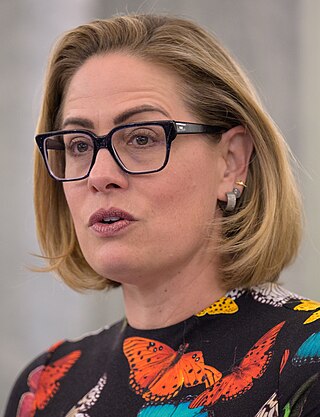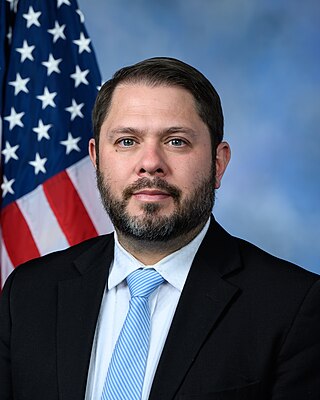
Michael Dean Crapo is an American lawyer and politician serving as the senior United States senator from Idaho, a seat he has held since 1999. A member of the Republican Party, Crapo served as the U.S. representative for Idaho's 2nd congressional district from 1993 to 1999. He is the dean of Idaho's congressional delegation, having served since 1993.

The United States Senate Committee on Banking, Housing, and Urban Affairs, also known as the Senate Banking Committee, has jurisdiction over matters related to banks and banking, price controls, deposit insurance, export promotion and controls, federal monetary policy, financial aid to commerce and industry, issuance of redemption of notes, currency and coinage, public and private housing, urban development, mass transit and government contracts.
The Democratic Senatorial Campaign Committee (DSCC) is the Democratic Hill committee for the United States Senate. It is the only organization solely dedicated to electing Democrats to the United States Senate. The DSCC's current Chair is Senator Gary Peters of Michigan, who succeeded Nevada's Catherine Cortez Masto after the 2020 Senate elections. DSCC's current executive director is Christie Roberts.

Political party strength in U.S. states is the level of representation of the various political parties in the United States in each statewide elective office providing legislators to the state and to the U.S. Congress and electing the executives at the state and national level.

The 1978 United States Senate elections were held on November 7, in the middle of Democratic President Jimmy Carter's term. The 33 seats of Class 2 were contested in regular elections. Special elections were also held to fill vacancies.
This article covers the history of women in the United States Senate and various milestones achieved by female senators. It includes a list of all women who have served in the Senate, a list of current female senators, and a list of states represented by women in the Senate. The first female U.S. senator, Rebecca Latimer Felton, represented Georgia for a single day in 1922, and the first woman elected to the Senate, Hattie Caraway, was elected from Arkansas in 1932. Sixty women have served in the upper house of the United States Congress since its establishment in 1789. As of October 3, 2023, there are 25 women serving as U.S. senators. Additionally, Kamala Harris as vice president serves as President of the Senate.

The Democratic Caucus of the United States Senate, sometimes referred to as the Democratic Conference, is the formal organization of all senators who are part of the Democratic Party in the United States Senate. For the makeup of the 118th Congress, the caucus additionally includes three independent senators who caucus with the Democrats, bringing the current total to 51 members. The central organizational front for Democrats in the Senate, its primary function is communicating the party's message to all of its members under a single banner. The present chair of the Senate Democratic Caucus is Chuck Schumer of New York.

Peter Francis Welch is an American lawyer and politician serving since 2023 as the junior United States senator from Vermont. A member of the Democratic Party, he was the U.S. representative for Vermont's at-large congressional district from 2007 to 2023. He has been a major figure in Vermont politics for over four decades, and is only the second Democrat to be elected a senator from the state.

Party divisions of United States Congresses have played a central role on the organization and operations of both chambers of the United States Congress—the Senate and the House of Representatives—since its establishment as the bicameral legislature of the Federal government of the United States in 1789. Political parties had not been anticipated when the U.S. Constitution was drafted in 1787, nor did they exist at the time the first Senate elections and House elections occurred in 1788 and 1789. Organized political parties developed in the U.S. in the 1790s, but political factions—from which organized parties evolved—began to appear almost immediately after the 1st Congress convened. Those who supported the Washington administration were referred to as "pro-administration" and would eventually form the Federalist Party, while those in opposition joined the emerging Democratic-Republican Party.

Kyrsten Lea Sinema is an American politician and former social worker serving as the senior United States senator from Arizona, a seat she has held since 2019. A former member of the Democratic Party, Sinema became an independent in December 2022.

Rubén Marinelarena Gallego is an American politician and former U.S. Marine serving as the U.S. representative for Arizona's 3rd congressional district. Gallego served and deployed as a USMCR Corporal in the US invasion of Iraq.

The 2012 United States House of Representatives elections in Arizona were held on Tuesday, November 6, 2012, to elect the nine U.S. representatives from the state, one from each of the state's nine congressional districts, including the newly created 9th district following the 2010 United States census. The elections coincided with other federal and state elections, including a quadrennial presidential election, and a U.S. Senate election. Primary elections were held on August 28, 2012.

The 2018 United States Senate elections were held on November 6, 2018. Among the 100 seats, the 33 of Class 1 were contested in regular elections while 2 others were contested in special elections due to Senate vacancies in Minnesota and Mississippi. The regular election winners were elected to 6-year terms running from January 3, 2019, to January 3, 2025. Senate Democrats had 26 seats up for election, while Senate Republicans had 9 seats up for election.

The 118th United States Congress is the current meeting of the legislative branch of the United States federal government, composed of the United States Senate and the United States House of Representatives. It convened in Washington, D.C., on January 3, 2023, and will end on January 3, 2025, during the third and fourth years of President Joe Biden's term in office.

The 2018 United States House of Representatives elections in Arizona were held on November 6, 2018, to elect the nine U.S. representatives from the State of Arizona, one from each of the state's nine congressional districts. The elections coincided with the 2018 Arizona gubernatorial election, as well as other elections to the U.S. House of Representatives, elections to the United States Senate and various state and local elections. The 2018 general elections saw the Democratic party gain the 2nd congressional district, thus flipping the state from a 5–4 Republican advantage to a 5–4 Democratic advantage, the first time since the 2012 election in which Democrats held more House seats in Arizona than the Republicans.

The 2024 United States Senate elections are scheduled to be held on November 5, 2024, as part of the 2024 United States elections. Thirty-three of the 100 seats in the U.S. Senate will be contested in regular elections. Senators are divided into three classes whose six-year terms are staggered so that a different class is elected every two years. Class 1 senators will face election in 2024.

The 2024 United States Senate election in Arizona will be held on November 5, 2024, to elect a member of the United States Senate to represent the state of Arizona. Primary elections will take place on July 30, 2024.
The Replace Sinema Project, formerly known as Primary Sinema Project and Primary Sinema PAC, is a political fundraising and advocacy initiative in the United States dedicated to defeating U.S. Senator Kyrsten Sinema (I-AZ) in the 2024 election.

The 2024 Arizona elections will be held in the state of Arizona on November 5, 2024, coinciding with the nationwide general election. One of the state's U.S. Senate seats will be up for election, as will all nine of its seats in the U.S. House and three of the five seats on the Arizona Corporation Commission.














